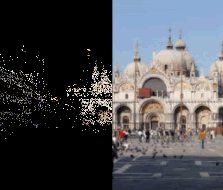Invention and Innovation: Microsoft's Photosynth
Saturday, June 09, 2007
In the Operations Research field people like to distinguish between these two terms: invention and innovation. Innovation comes from invention, and invention becomes innovation only if someone starts using it for something. So invention is something that just comes to be for whatever reason. Either someone invented it, or it was just there to be discovered--is there are difference? Finally, in our modern times, marketing makes inventions innovations.
Innovation is a philosophy and a process, I have
said, and you can't force anyone or any organization to be innovative. But when you have the mind-share and the resources to provide an innovative working environment, great things come to life.
The most innovative companies right now, I think, or at least have the most money to promote their "innovations," are google and Microsoft. (Apple is still innovative, but hardware is not too much my thing.)
I write too much about google (because they get developers, or is it
Ballmer who loves developers the most?), so I decided to balance the scales and talk about a particular Microsoft lab "creation."
I put
creation in quotes here because it was actually an acquisition that brought this technology under their roof. Note that an acquisition is still part of innovation management, or technology change management. The innovation part comes from identifying a gap within the organization and deciding to buy whatever technology or product to fill it.
Microsoft and google do this quite often: they buy companies and technology left and right. Note that acquisition for acquisition's sake is bad: what makes an acquisition a success is the fit within the organization's overall strategy.
The product that I think is so innovative is called
Photosynth (a combination of two products, CDragon and PhotoTourism--these may not be spelled correctly).
Play around with the demo and you'll get hook on it.
It's quite a remarkable idea. The premise of CDragon, one of the products, is the analysis of a collection of images into a navigable map of pictures. Typical images take a lot of disk space, and to have a large number of them displayed on your screen at the same time is CPU and RAM intensive.
With this product the limitation is only the number of pixels on your screen, as the "zooming" is done in real-time and only the information that is needed to make sense of an image (the clarity of it) is displayed at a time.

Photosynth, which is the demo for the link above, is the combination of the two products I mentioned. With Photosynth users create collages of pictures as a 3D map of disjointed images--thousands of photos taken by different people at different times and from different perspectives.
I'm not sure if the blending is computer or manually generated, but the effect of the complete collage is something to behold.
External links (will open in new windows):
By the way, I was reading through Harvard Business Review and they have a special report of innovation: 24 pages or 4 or 5 articles, discussing innovation transfer, philosophies, and why it is needed to stay competitive. You know a topic is hot when it hits the mainstream.
Comments: